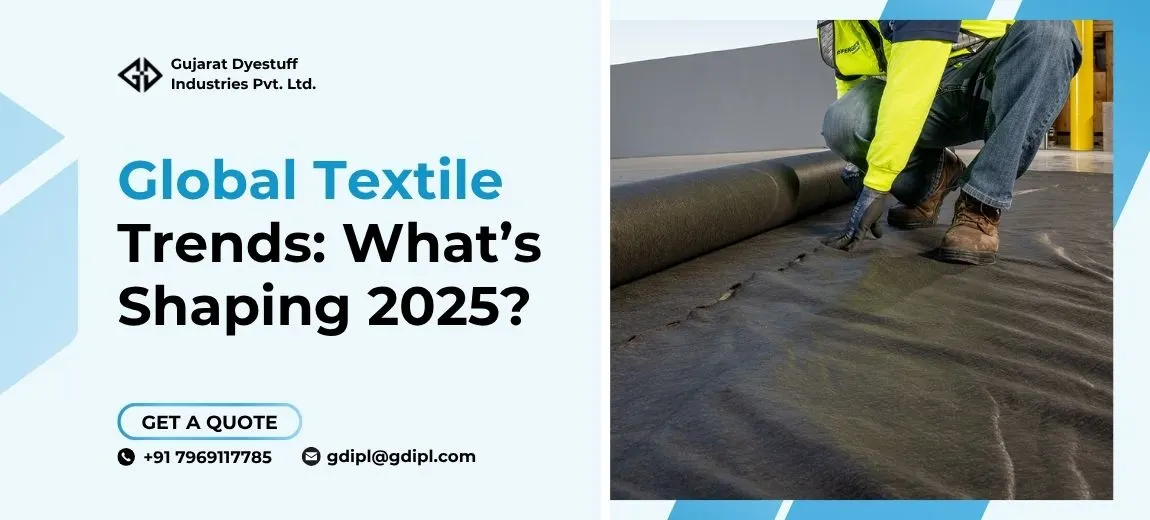Global Textile Trends: What’s Shaping 2025?
Views : 253

The global textile industry is in the midst of a fascinating transformation. As sustainability, innovation, and digitalization take center stage, the way textiles are produced, used, and valued is being redefined. From fashion runways to infrastructure, textiles are weaving their influence far beyond traditional fabrics.
So, what’s shaping the global textile landscape as we head into 2025?
Let’s dive into the key trends, technologies, and materials—like geotextile—that are revolutionizing the textile space, and how leading players like Gujarat Dyestuff Industries Pvt. Ltd. (GDIPL) are making a mark.
A Snapshot: The Evolving Textile World
In 2025, the textile industry won’t just be about threads and colors—it will be about smart textiles, performance fabrics, environmental responsibility, and high-tech applications. Whether it’s a luxury jacket made from recycled bottles or a road built with durable geotextile fabric, textiles are serving a wider purpose.
Here are the major trends making waves:
1. Sustainable Textiles Are Going Mainstream
Eco-conscious consumers are driving brands to source better. Organic cotton, bamboo, and hemp are no longer niche—they're now market essentials. Meanwhile, manufacturers are adopting zero-waste production, low-impact dyes, and circular textile systems.
GDIPL, with its legacy of 43+ years in specialty textiles and chemicals, is actively supporting sustainable innovation with environment-friendly products and processes.
2. The Rise of Technical Textiles
Beyond apparel, textiles are being engineered for performance in fields like construction, agriculture, healthcare, and mobility. This category includes nonwovens, smart textiles, and most importantly, geotextile fabrics.
As a trusted supplier to infrastructure and industrial clients, GDIPL has strengthened its technical textile portfolio with a focus on durability, quality, and innovation.
3. Geotextile: The Fabric Beneath Our Feet
Among technical textiles, geotextile is one of the fastest-growing segments globally. These synthetic fabrics are used in civil engineering to reinforce soil, control erosion, and manage drainage in roads, railways, landfills, and coastal structures.
Whether it's woven or nonwoven geotextile, demand is booming due to the push for infrastructure development in emerging economies and eco-smart construction practices.
Why GDIPL for Geotextile?
With decades of chemical and textile expertise, Gujarat Dyestuff Industries Pvt. Ltd. offers engineered geotextile solutions known for their strength, resistance, and performance across climates. Trusted by infrastructure giants, GDIPL’s products are a blend of science, precision, and reliability.
4. Digital Transformation in Manufacturing
AI, IoT, and machine learning are transforming textile production—reducing waste, increasing efficiency, and enabling mass customization. Smart manufacturing isn’t optional anymore; it’s the standard.
GDIPL integrates modern manufacturing technologies to ensure consistency, quality, and responsiveness in every order—whether it’s a bulk supply of geotextile or specialty dyed fabrics.
5. Smart and Functional Fabrics
Textiles that can sense, react, and adapt are shaping the future of fashion and medicine alike. From temperature-regulating athletic wear to antimicrobial hospital linens, functional fabrics are gaining traction.
6. On-Demand & Localized Production
The global supply chain disruptions have triggered a shift toward local, agile production hubs. Micro-factories, 3D printing, and regional sourcing are becoming the new norms.
GDIPL, with its India-based high-capacity units, is ideally positioned to serve both domestic and international clients with speed, flexibility, and trust.
7. Government Policies Fueling Growth
From India’s PLI scheme to EU’s Green Deal, textile policies are pushing for sustainability, digitization, and innovation. These shifts are creating massive opportunities for forward-looking players.
GDIPL, established in 1981, is perfectly aligned with global goals, having consistently evolved with industry needs and regulatory landscapes.
Final Thoughts
As 2025 approaches, the textile industry isn’t just growing—it’s transforming. With innovations like geotextile, smart manufacturing, and sustainable production taking the lead, the future of textiles looks promising and purposeful.
For companies seeking reliable, forward-thinking partners in this journey, Gujarat Dyestuff Industries Pvt. Ltd. (GDIPL) stands as a beacon of quality, consistency, and innovation.

